VIDEO FEATURE & WEB-EXCLUSIVE INTERVIEW
EXPERIENCE VINYL
Experience Vinyl is more than a record a month club. It’s a total customer experience with special concerts and unique member-only benefits. Each month, members will receive a selection of the featured artist-curator’s essential “Desert Island Disc.” Accompanying the record will be a personal description written by or for the artist about why the record is so important. In addition to the curated album, membership may also include a unique bonus gift determined in collaboration with the artist—giveaways, trips and invites to Experience Vinyl’s quarterly concerts.
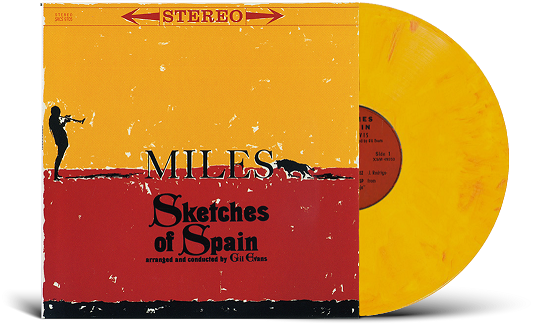
Miles Davis’ Sketches of Spain – vinyl
The initial slate of artist-curators for the Experience Vinyl subscription service includes Elton John, Quincy Jones, George Clinton, Talib Kweli, Carlos Santana, Sean Lennon and more.
Brad Hammonds’ 2014 DesertAlbums.com blog was the initial idea that launched this new venture. He’s also a touring musician who can provide an insider’s unparalleled perspective.
We talked with founders Brad Hammonds and Jake Fishbein about this innovative idea to help people slow down and appreciate music, and their plans to creative a unique customer experience for their ExperienceVinyl.com subscribers.
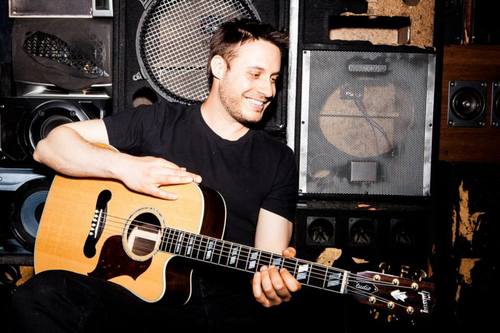
Brad Hammonds
EXPERIENCE VINYL—BRAD HAMMONDS & JAKE FISHBEIN Web-Exclusive Interview with M Music & Musicians magazine publisher, Merlin David
How did the concept of Experience Vinyl evolve?
Brad: I’m a professional touring musician and I started a blog called “Desert Albums,” where I would ask my jazz friends and others to give me their Top 10 favorite albums. I got Vernon Reid of Living Colour, Al Jarreau, Regina Carter (the violinist)—I was doing a lot of jazz at the time. I got a lot of my musician friends, like Mark Guiliana, who is an amazing drummer. Vernon sent me his list, and told me why. And I found out people liked to read about great musicians—why they chose the albums, who influenced them, what inspired them. Out of that, Jake and I started discussions of what medium we can use to get these amazing musicians’ favorite albums out there—and can we expand and get bigger artists to give us their favorite records. Vinyl is back in a big way. It’s beautiful, and feels great. It slows you down. You listen from start to finish.
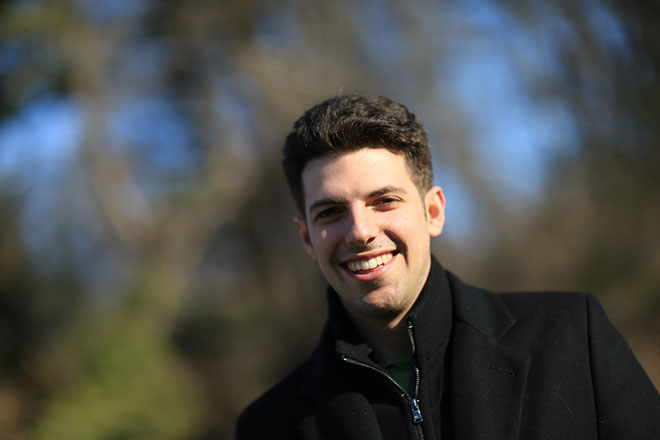
Jake Fishbein
Tell us a little about your musical background.
Brad: I was touring with a duo called Brazz Tree—a violinist and I toured colleges, universities and theaters. I signed Hannah Gill to my record label, when she was 16 years old. She is now 19, and she has postponed college to do music full time. We recorded an EP, and got a great booking agency that helps with touring. Things are going really well. We had some great press, and we have videos out there. She’s amazing—a big bluesy, deep-sounding voice. It’s a throwback record called The Water by Hannah Gill & the Hours. It’s Hannah, me and a big horn section. We play in the city a couple of times a month, and we finished our first national tour this past December.
Tell us about “Austin”—her most recent video?
Brad: I wrote that the morning of a wedding where a guy named Austin was getting married. I just woke up and wrote it, and then collaborated with Hannah and others in the studio to bring it to life. We decided to go to Austin TX to shoot the video.
Jake, you’re the partner and also a writer?
Jake: I just finished the draft of my first novel. My background is in writing, project coordination and publicity.
Brad: Jake came on as part of my record label. We work together on the label. We started talking about Experience Vinyl, and we thought ‘let’s do this too.’ It’s been such a blast doing both, and now we have some more team members to help out with Hannah, so we can focus on Experience Vinyl.
When did you get this idea?
Jake: It was definitely more inspired from Brad’s side—he’s a huge audiophile—vinyl. He has a record player setup in his apartment. I started working with him last summer. We’re both entrepreneurs. He loves creating things, and we both hit upon this shared concept—for the purpose of slowing down. Vinyl is perfect for that—for listening to the entire album and not looking at Facebook, Twitter and Instagram—and baseball game at the same time. It fit perfectly with DesertAlbums.com—Brad’s blog. We honed in on the concept together and got it to this Vinyl of the Month Club curated by these iconic artists.
This innovative concept will attract all consumers and all music lovers, but who is your specific target audience?
Brad: Because we’ve gotten more iconic artists, it’s intended more for 35-50 professionals, with more disposable income, who collect vinyl. Less so, the hipster—although we just signed a curator who will appeal to that target. Because we have a lot of iconic artists, and announcing more in the coming weeks—rock ’n’ roll hall of fame platinum artists—we are going to appeal to more of that target demographic. We’re still doing exclusive color vinyl, so we will still appeal to younger vinyl lovers.
How do you get Artists to be involved?
We have 12-15 in-between stages of signing contracts and signed contracts. When we started, we knew this would be our biggest challenge. Once a few curators signed on, a lot of others signed on. We’re working with Michael Frisch, an entertainment lawyer. He knows a lot of people, but it’s really about going to managers, soliciting, and telling them about the project. Quincy Jones is a huge producer, and he loved the idea and hopped on. Some people are really into the idea. They love music and love talking about why they love it.
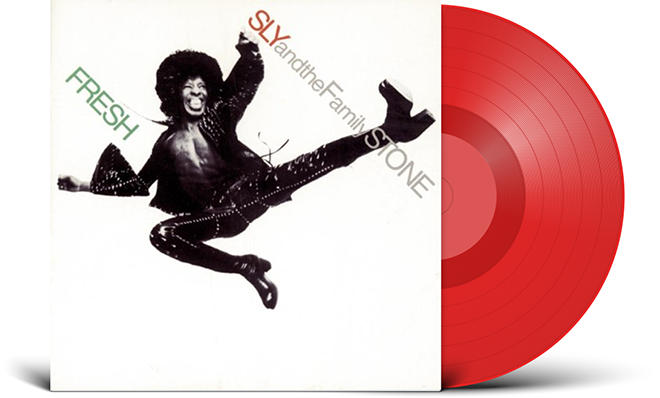
Sly and the Family Stone – Fresh – red vinyl
That’s probably the toughest part—to get people to commit.
Jake: By far! (Laughs)
Brad: We were initially in panic mode—no one’s signing on. Is this going to fly? How deep do we have to go? Maybe it’s just Hannah’s picks. (Laughs)
Which curators jumped in?
Sean Lennon was the first: ‘Yes, I’ll definitely do this.’ We were excited because we figured he’d pick his dad [John Lennon], and write about him—which would be so epic. Then CeeLo Green, Chris Robinson, and Elton John signed on.
Who on the jazz side of things signed on?
Brad: We have Quincy Jones, and he’s a legend in that world. I would love to get Wayne Shorter, Herbie Hancock, Esperanza Spalding. A lot of people are picking Miles Davis and John Coltrane. Michael Frisch works with Ravi Coltrane, John’s son. We’re working on getting him more involved. As a jazz musician, I have Top 10’s from some great jazz artists, and I have a lot of fun seeing those records on lists. We talked with George Clinton about Miles Davis, and those conversations are surreal. I think, ‘I can’t believe I’m having this experience right now.’ It’s like an out-of-body experience.
What are you offering that is different from the record clubs of old?
Our angle is access to these big rock stars—what are their favorite albums and why they love them. The questionnaires they are answering provide a deep insight into why they picked their albums. Since it is vinyl, it’s exclusive to our members. It will be color. And we have quarterly concerts. We threw a concert with Talib Kweli at the Brooklyn Bowl. We have a lot of membership perks. We’re new, but we want to create an experience. Not just a record a month. We worked with the Brooklyn Bowl in Brooklyn NY for that show. We’re talking about doing an event in LA in a couple of weeks. A portion of the sales goes back to charity. We want to give back to the arts. Elton is giving to his AIDS Foundation. We also want to do some good. At the end of the day, it is entertainment—it’s music, it’s fun.
How do you communicate with the curators?
Jake: Michael Frisch is our liaison with the artists. Once they’re signed onboard, then both Brad and I communicate with them. My job is operations—overseeing everything, making sure everything is running smoothly, and staying on top of customer service—creating that experience for our customers. And making sure our website is in line with the experience we want to create. In our office, we throw around ideas all day long—how can we create a better experience for our members. It’s all about the context we create around Experience Vinyl. Our record club is about that experience.

George Clinton
What are the challenges?
Brad: One of the challenges with vinyl right now is that the demand is so high, and there are only so many plants that are vinyl. There’s a long lead time. We have to make sure we forecast properly, but also we’re on top of the labels and the manufacturing of the pressing. It’s been tough, but that’s what Jake is on top of.
Where are the plants?
Brad: There’s one we’ve been working with in LA. And Jack White just opened a big one in Detroit, which is one of the newest. Most of them went out of business, but with the resurgence of vinyl, people found the big systems to make them on eBay, or with plants closing there are these epic stories of people finding machines and opening shop. They are hard to find.
Who inspired you to collect albums?
Brad: I grew up in the grunge world. For me, it’s the age old story. When I used to go to Tower Records, the guy behind the counter would say ‘Go grab this album.’ I would come home with a record and put it on, and look through the liner notes—and read the lyrics. Sit there with it. Now, it’s much more passive listening. With whatever artist for me—Paul Simon, Peter Gabriel—that idea of actually sitting down and putting a record on, and listening to it from start to finish—that’s what I love. Not just working and Spotifying music—although I do that as well. (Laughs)
How does vinyl help create a different experience?
Brad: Just slowing way down and looking through the artwork. I used to get so excited—driving home from the record store, with records in my bag, thinking ‘I can’t wait to get home, open these up, put them on, sit down, and once the first note starts—thinking ‘oh yes, this is going to be fun.’ It’s magic, and it’s difficult to put your finger on it. I’ve heard of people who don’t have record players, and then they do it and experience that magic—and realize, ‘Wow. My life just changed.’ That’s when they realize—this is the way it should be. I should spend some time actually listening to the music. I’m not saying that passive listening is bad because I do it a lot. While I’m working, I listen to music. But there’s something about conscious active listening that a lot of us are missing out on.
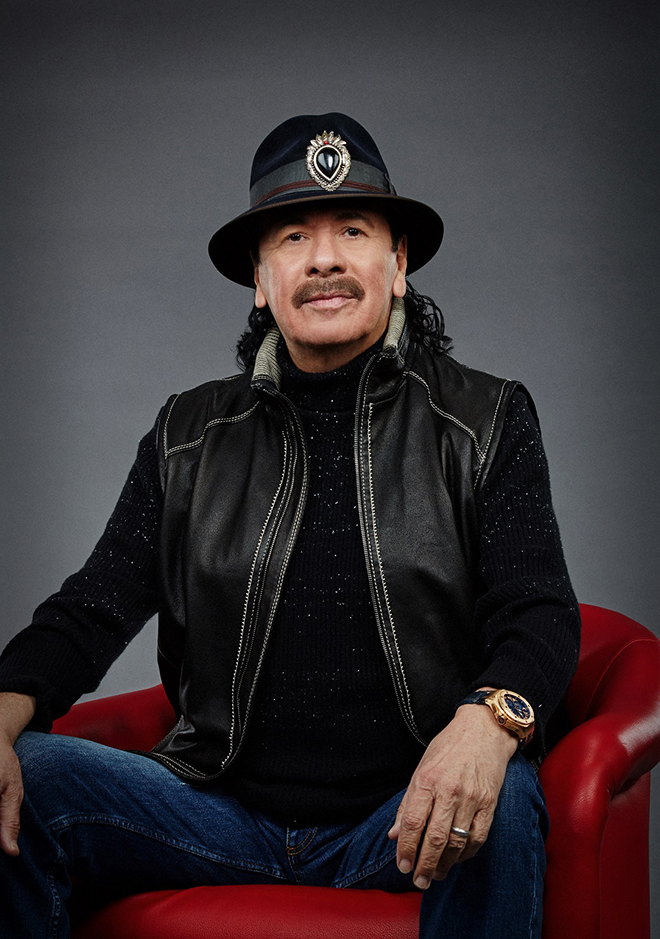
Carlos Santana
What are your Top 10 Desert Album picks?
Brad: If you can get away from thinking what people will think of you, then it’s easy. If not, it’s difficult. A lot of musicians feel they have to pick certain artists because of their perceived persona. But here goes:
The Rhythm of the Saints (1990) – Paul Simon
Kid A (2000) – Radiohead
Friday Night in San Francisco (1981) – Al Di Meola, John McLaughlin and Paco de Lucía
Rage Against the Machine (1992) – Rage Against the Machine
Led Zeppelin III (1970) – Led Zeppelin
The Score (1996) – Fugues
Dilate (1996) – Ani DiFranco
Lateralus (2001) – Tool
Shakti with John McLaughlin [Live] (1976) – Shakti
Us (1992) – Peter Gabriel
Jake: People are probably going to judge me anyway, but here goes:
Zorba the Greek [soundtrack] (1965) – Mikis Theodorakis
The Scarlet Pimpernel (1998) – Original Broadway Cast Recording
Polihroma Kai Entona (2000) – Notis Sfakianakis
Sun (2014) – Thomas Bergersen
Ultimate Sinatra (2015) – Frank Sinatra
Titanic: A New Musical (1997) – Original Cast Recording
Best of Glykeria (2007) – Glykeria
The Wild Feathers (2013) – The Wild Feathers
Dear Agony (2009) – Breaking Benjamin
Mondo Greece (2001) – Various Artists
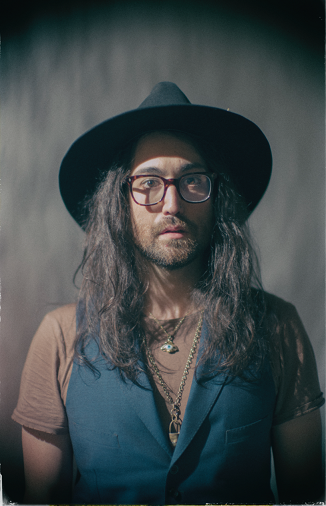
Sean Lennon
Do you remember your first concert experience?
Brad: My first concert was Soundgarden opening up for Gun N’ Roses. It blew my mind.
Jake: I absolutely love music, and yet my knowledge of it has been severely hindered. My first concert was when I moved to New York City and I saw The Wild Feathers. But when I was in elementary school, listening to Big 98.5 (an oldies station in Albuquerque New Mexico where I grew up), my parents took my brother and me to this oldies concert and the guy sang songs about a bouncing ball. I was 8, and we were the youngest kids in the entire audience. I grew up in the era of Britney Spears, Backstreet Boys and ’N Sync—listening to Sinatra, the Beatles, musicals, and Greek music—I was obsessed. I’m a little younger than Brad, so I didn’t grow up in the vinyl era. But I used to ride my bike to the local Borders [bookstore] and flip through the CD stacks—finding cool Greek music. I would play them while I read books. I still know some of those songs but I have no idea what the words mean. (Laughs) Just goes to show you the power of music. You don’t need to know what the words are saying to get the meaning behind the songs.
How many subscribers did you need to launch this?
Brad: We wanted a couple of hundred to initially sign up, and we reached our goal. We just want to get as many people to sign up. Now we’ll be happy with whatever we get from here on. Our first record shipped in April—on April 22, 2017—to coincide with Record Store Day. It was Talib Kweli’s pick: A Tribe Called Quest’s Midnight Marauders. He also picked John Coltrane’s A Love Supreme and Nas’ Illmatic. May was George Clinton’s pick: Sly and the Family Stone’s Fresh. June will be Carlos Santana’s pick: Miles Davis’ Sketches of Spain, etc.
After you get the curator’s list, what is the turnaround time?
Jake: For the most part, 99% of the time, we’re working 2-3 months in advance. Getting a curator signed, getting the contract, getting their deliverables, essays, photos, bio, getting the album pressed. We’re already working on late summer right now.
Do you want your subscribers to know which album they will get?
Brad: We are still learning. We’re keeping it close to our chest until the month of—that’s our goal. But maybe we’ll find that people want to know three months in advance. Obviously, it’ll be exclusive, and a colored vinyl. You won’t be able to just go and buy the record, but as of right now, we’re going to list a couple of their Top 10s and leave the Top 3 out until the month.

Talib Kweli
Best advice someone has given you.
Brad: From a company perspective, and as a musician, you have to remember it’s music. You can get so bogged down in the rejection or the art of it—which is a very serious aspect of it. But at the end of the day, we all do this because we love it. We started this company because we have a passion for music. I play music because I love it. But the business of music drives people crazy—worrying ‘How do I make it?’ And I just tell people, take it one day at a time, and love it. You’re doing it because you love it. Don’t do it to ‘make it.’ Chances are, that probably won’t happen. If it does—amazing. But do it because you love it. We have to constantly remind ourselves. We get overly stressed, and realize—we’re not saving lives here—it’s just records. (Laughs) It’s the same with music: ‘that show was simply awesome—let’s enjoy that.’ You get so bogged down in that arena of success and money—and sometimes forget the art—you forget the purpose.
What’s next?
Brad: We have curators we’d love to get—specific goals there—some specific names we’d like to get. But we would love to hit 10,000 subscribers. I don’t know if next year is realistic, but that’s our big goal. And get more involved in concerts. We’re always brainstorming on what other ideas we can do with these artists, aside from just vinyl—which is the medium. The ideas of albums that they love, the deep insight into them. We’ve talked about getting the general public involved and telling us what they love—sharing their top albums. And crowdsourcing records—what records would you love on colored, exclusive vinyl. We want to build it out into an online record store based on our curator’s picks, and potentially build a turntable. I could go on forever. (Laughs)
Where can consumers get more info?

Hannah Gill and The Hours
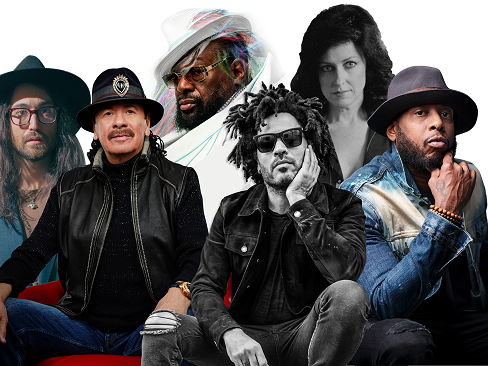

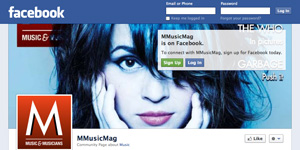
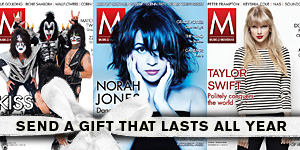
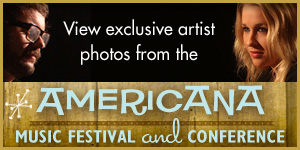
comment closed